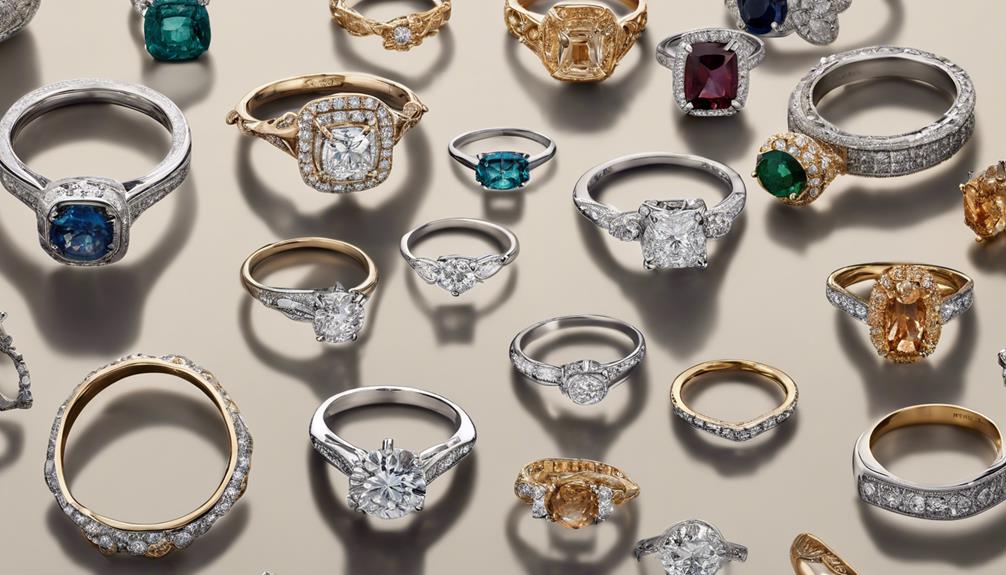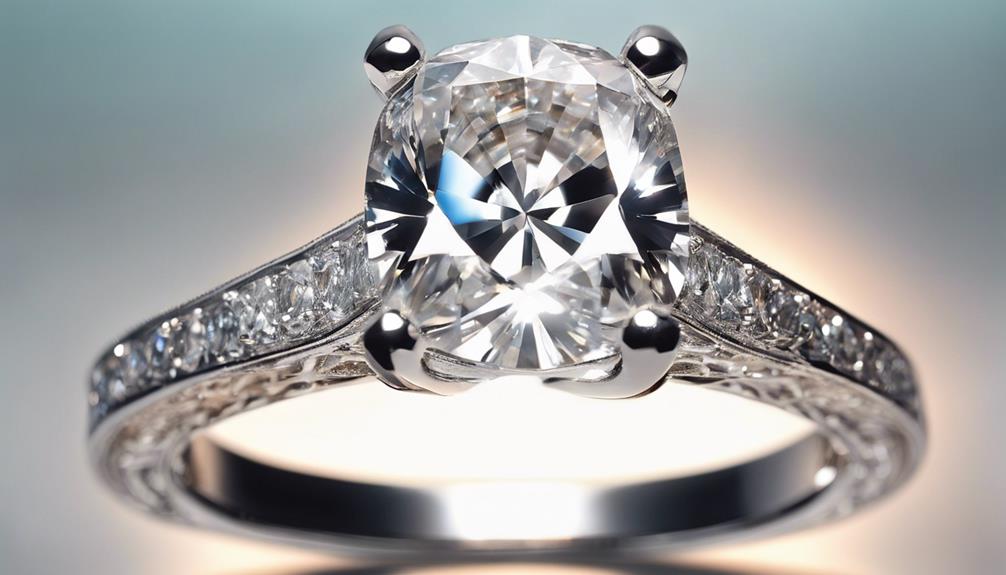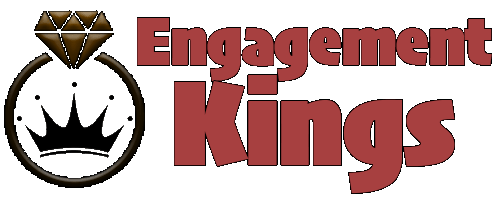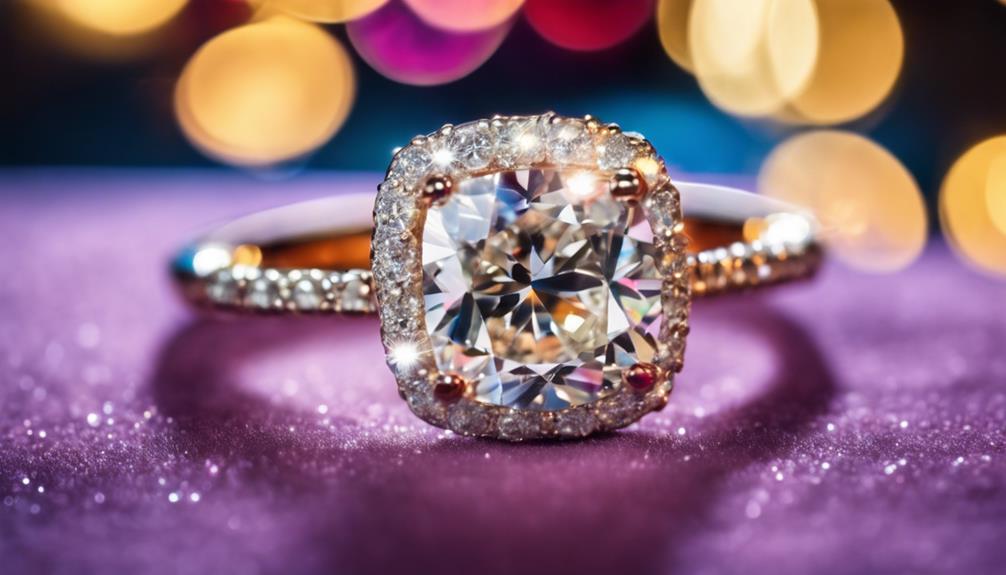You’re on an exciting path to find the perfect engagement ring that matches your love story. Explore styles like the classic solitaire or the symbolic three-stone setting. Choose between traditional diamonds or alternative gemstones based on personal significance. Understand the 4Cs—cut, color, clarity, and carat weight—to evaluate diamond quality. Consider different settings, from prong to halo, that affect both the stone’s protection and beauty. Set a clear budget, keeping in mind factors like lab-grown diamonds and additional costs. Each step of this journey holds insights to help you find a ring that truly resonates with your relationship.
Understanding Engagement Ring Styles

When you’re choosing an engagement ring, understanding the various styles is essential to finding the perfect fit for you or your partner. Engagement ring styles are more than just aesthetics; they reflect personal taste and the unique story of your relationship.
Among the popular ring settings, the solitaire stands out for its timeless simplicity. This style features a single diamond, making it a classic choice that showcases the stone’s brilliance and elegance.
If you’re seeking symbolism, the three-stone setting is a meaningful option. It represents the past, present, and future with a central diamond flanked by two smaller stones, offering a sophisticated and sentimental touch. Each stone can even be a different shape, allowing you to personalize your ring further.
Speaking of diamond shapes, there are twelve common ones, including round, princess, and pear, each contributing a distinct personality to the ring.
Whether you prefer the understated elegance of a solitaire or the heartfelt significance of a three-stone, understanding these engagement ring styles will guide you in selecting a ring that resonates with your love story, ensuring it’s as unique and beautiful as your relationship.
Choosing the Right Gemstone
As you explore engagement ring styles, the choice of gemstone adds another layer of personalization and meaning to your selection. Gemstones offer a variety of symbolism; for example, sapphires stand for loyalty, and emeralds symbolize rebirth and growth. Your personal preference will guide you in selecting a stone that reflects your values and emotions.
Alternative gemstones like morganites and sapphires are becoming popular not just for their unique aesthetics but also because they often cost less than traditional diamonds.
When choosing a gemstone, consider the color’s emotional significance. Light shades can evoke calmness, while deeper hues might symbolize passion. This allows you to infuse your ring with personal meaning based on what resonates with you.
Ethical sourcing is another essential aspect of your decision. Many buyers now prioritize gemstones with traceable origins to guarantee they’re not contributing to conflict or unethical practices. By selecting ethically sourced stones, you contribute to a more sustainable and fair industry.
Ultimately, your engagement ring should reflect your unique style and story. Whether you opt for a traditional diamond or an alternative gemstone, make certain it aligns with your values and preferences.
Diamond Quality and the 4Cs

Diving into the world of diamonds, you’ll quickly encounter the Four Cs: Cut, Color, Clarity, and Carat. These are essential criteria for evaluating diamond quality.
The Cut is significant, as it determines a diamond’s brilliance and sparkle. A well-cut diamond reflects light beautifully, enhancing its allure.
When considering the Color grade, remember that diamonds are rated from D (colorless) to Z (light yellow/brown). D-grade diamonds are the most sought after, given their lack of color and rarity.
Clarity refers to the presence of internal inclusions and external blemishes. Diamonds are graded from Flawless, which have no inclusions visible under 10x magnification, to Included, where inclusions can be seen with the naked eye.
The fewer the inclusions, the higher the diamond quality.
Carat weight measures the diamond’s size, with one carat equaling 0.2 grams. While larger diamonds often carry a heftier price tag, it’s essential to balance size with quality in the other Cs.
Prioritize which of the Four Cs matter most to you. This helps manage your budget and guides you in selecting the perfect diamond that aligns with your desires.
Ring Settings and Their Impact
Choosing the right ring setting is essential, both for enhancing the beauty of your diamond and ensuring its security. When selecting a diamond engagement ring, the setting plays a critical role in both the stone’s appearance and protection.
A prong setting, for example, is popular for maximizing light exposure, which enhances the diamond’s brilliance, but it might offer less protection than other options. In contrast, a halo setting surrounds the center stone with a circle of smaller diamonds, adding extra sparkle and creating the illusion of a larger diamond.
Each ring setting type offers a unique aesthetic and level of security. While settings like bezel and pavé provide more protection by encasing the diamond more fully, they also alter how light interacts with the stone. This interaction directly impacts the diamond’s sparkle, which is a vital aspect to take into account for your engagement ring.
Custom settings allow you to incorporate personal touches, reflecting your unique style and preferences in your ring. By working with a jeweler, you can create a one-of-a-kind design that perfectly balances beauty, security, and personal significance, ensuring your diamond engagement ring is truly special.
Factors Affecting Your Budget

Setting a clear budget is vital when you’re shopping for an engagement ring, as it helps guide your choices and keeps spending in check. Typically, budgets range from $1,000 to $10,000, but they can vary depending on personal financial circumstances and preferences.
Start by determining how much you’re comfortable spending, taking into account the significant factors that affect the cost of a diamond.
The Four Cs—cut, color, clarity, and carat—are essential in determining a diamond’s quality and price. Prioritize these aspects based on what matters most to you. For instance, if size is your top priority, you might opt for a slightly lower clarity or color to stay within budget.
Consider lab-grown diamonds if you’re looking for cost-effective options. These diamonds can be 30-40% less expensive than mined ones, offering similar beauty and durability. This choice allows you to allocate more of your budget towards other factors or even a larger diamond.
Don’t forget additional costs like insurance, maintenance, and resizing, which can add 10-20% to your overall budget.
Research and compare prices across various jewelers to guarantee you’re maximizing your budget’s effectiveness.
Conclusion
In your quest for the perfect engagement ring, you’ve explored styles, weighed gemstone options, and decoded diamond quality. You’ve considered settings and budget, ensuring every choice reflects your unique love story. Remember, it’s not just about the sparkle; it’s about a symbol of commitment and shared values. Trust your instincts, prioritize what feels right, and cherish the journey. As you select this enduring symbol, know it captures a love that will shine for a lifetime.



